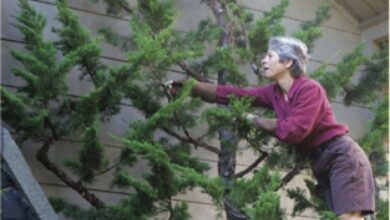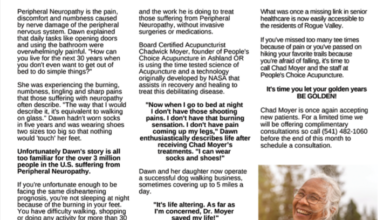Abigail Hatfield – Anjali Yoga Therapy & Mindful Yoga for Chronic Pain
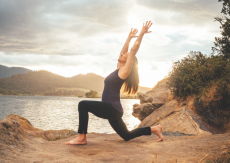 Abby Hatfield has been a devoted student of yoga for over 20 years. She believes that through regular practice, we carry the ancient yogic wisdom forward into our lives, reducing suffering, improving relationships, and increasing compassion. Abby’s devotion to the practices, and to her students, drives her to continually study, grow, and learn as a teacher. In today’s interview, I speak with her about these principles and the practice of yoga for specific conditions, such as chronic pain, anxiety, and trauma.
Abby Hatfield has been a devoted student of yoga for over 20 years. She believes that through regular practice, we carry the ancient yogic wisdom forward into our lives, reducing suffering, improving relationships, and increasing compassion. Abby’s devotion to the practices, and to her students, drives her to continually study, grow, and learn as a teacher. In today’s interview, I speak with her about these principles and the practice of yoga for specific conditions, such as chronic pain, anxiety, and trauma.
Hi Abby and welcome to LocalsGuide!
Thanks Shields – I’m happy to share and talk about my business!
Great, to begin with, can you please provide a little bit of information to us about yourself and your path in yoga?
I started practicing Iyengar Yoga as a college student in Pennsylvania in 1997. I had been in a car accident earlier that year, and I found that yoga helped with pain relief. Since then, the personal benefits that yoga has brought me are immeasurable. When I moved to Oregon in 2000, I expanded my yoga studies to include Anusara Yoga. I loved the heart-opening philosophy, and as I dove deeper into the study of alignment principles, I felt an inner alignment taking place. Yoga became an integral part of my life. I went through a period of grief and illness in 2008. On my path of recovery, yoga was my deepest healer. I decided to become a Yoga Therapist, so that I could share the healing power of yoga with others. I became a Registered Yoga Teacher in 2009, and a Yoga Therapist in 2014 (Certified by the International Association of Yoga Therapists in 2017). I now specialize in teaching students who have chronic pain, limited mobility, anxiety, and trauma.
Outside of being a teacher you also have your own relationship with yoga.
Yoga helps me to find balance amidst the sometimes tumultuous waves of life. It also helps me to feel good in my body, and in-tune with my nervous system, which in-turn helps my relationships. I can honestly say that every aspect of my life is positively affected by my yoga practice, which includes not only postures and breathing, but also meditation and the philosophy of yoga.
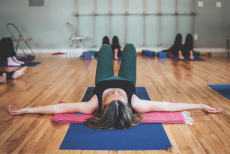 Abby, can you please give us an overview of your services?
Abby, can you please give us an overview of your services?
I offer three types of services: classes, private sessions, and workshops.
-I currently teach two weekly classes at Rose Yoga Center of Ashland; Adaptive Yoga and Level 1-2 Yoga. I teach an eight-week course called Mindful Yoga for Chronic Pain at Rose Yoga as well.
-I offer private, hour-long yoga therapy sessions at Wellspring Center for Body Balance, the chiropractic office of Dr. Timothy March Dr. Dan Helgerman.
-I also periodically teach workshops on topics such as Yoga for Scoliosis, Pelvic floor and Core, and a half-day Chronic Pain workshop. My website, www.anjaliyogatherapy.com, has current class schedules and upcoming workshop dates and locations, as well as information about private sessions.
Specifically, how are you using yoga for the management of chronic pain?
In 2017 I began studying Mindful Yoga for Chronic Pain with teachers Jim and Kimberly Carson at OHSU.
Since then I have become certified to teach their eight-week program, which was developed at Duke Integrative Health. This evidence-based program combines the philosophy of yoga, meditation, and mindful movement with current pain education models to alleviate and manage the symptoms of chronic pain. During the eight-week course, students learn techniques to manage stress, work with challenging thoughts and emotions, and gentle movement sequences. The class forms a community – students share with each other and learn from each other. Overall, the class addresses not only the physical aspects of chronic pain, but also the psychological and social. One student recently said “This course has taught me skills that I will be using for the rest of my life.”
Please talk more about Adaptive Yoga. What is it? How does it work?
Adaptive Yoga modifies, or adapts, traditional yoga postures for students who have special movement considerations. Many students in my Adaptive classes have one or more of the following: previous or upcoming hip or knee replacement, arthritis, osteoporosis, rotator cuff injury, Parkinson’s disease, MS, mastectomy, cancer, chronic pain. To minimize weight bearing on hands and knees, most of the postures are done seated in chairs or standing. A lot of people think that they can’t do yoga because of injury, disease, or inflexibility. Adaptive Yoga classes make it possible for EVERY BODY to do yoga!
Abby, what are the goals for all of your students?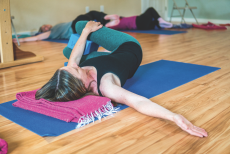
Most students come to class to gain flexibility, strength, balance, and freedom of movement, and this is their initial goal. However, I see these goals evolving over time. After a few months, students want to understand their bodies better and learn how to work skillfully with their strengths and limitations. They want to gain confidence in their movements. They also want to reduce stress, learn to breathe more effectively, and take some time for themselves in a supportive environment.
How effective is yoga for your students?
Yoga is very effective for my students, especially when they practice consistently over time. Even students who only come to class once a week report benefits. Students report that they are stronger, have better range of motion, and better sleep. I often hear students say “I couldn’t do this three months ago!”
What are common mistakes you see that can occur when first getting started and why is it important to work with a great teacher?
There are many styles of yoga, and not every style is right for every person. I often see students who try to push themselves into postures or practices that they are not ready for, and incur injury as a result. A great teacher will recognize postural misalignments and help students to find the appropriate modification for a posture. When a posture is done correctly, there should be a steadiness, and balance between effort and ease. Great teachers encourage new students to listen to their bodies to find the appropriate edge.
When students first come to you, how do you begin working with them?
When students come to me for private yoga therapy sessions, we begin with a general review of their health history, their concerns, and their goals for the practice. Then, I typically begin teaching simple breathing and meditation practices. The breath is foundational to the practice, and carries through all of the movement sequences. The meditation helps the students to become present, to let go of persistent thoughts, and to hone their awareness, bringing a calm and clear focus. Then we begin exploring range of motion through simple movements, such as arm raises.
How do you ensure that your students are safe and not incurring injury?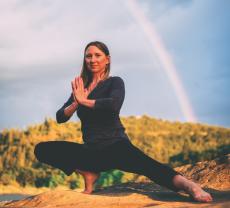
1. I ask them what they are feeling. I want to know that they are feeling a stretch or strengthening exercise in the intended muscle group. For example, if someone is doing a simple standing forward bend, which is intended as a hamstring stretch, but they are feeling strain in their low back, the posture is not effective. We modify or change the posture by softening the knees, hinging at the hip crease, or using props such as blocks to place the hands on.
2. I teach them to listen to their body’s cues, and help them differentiate between a positive response and one that warrants adjustments.
3. Especially when working with injuries, I make the pose fit the body, rather than trying to make the body fit the pose.
What are some other ways in which you are paying attention to your students?
I meet my students wherever they are. If they have had a hard day and need to decompress before beginning the practice, I provide space for that by just listening. By observing a student’s facial expressions, voice tone, body language, and breath, I can understand where they are, and what type of practice might be appropriate in the moment. Ultimately, I want the practice to be beneficial not only for the muscles and bones, but also for the nervous system, the mind, the emotions, and the spirit. I choose practices that help to balance all of those layers.
Yoga can also be used for anxiety and trauma. Please say more.
When a person has anxiety or trauma, they often report a feeling of disconnection or disassociation from their body. Yoga therapy helps people to get into their bodies, and to understand the mind-body connection.
For anxiety, I usually begin with breathing practices that shift the student’s physiology from the sympathetic (fight or flight) mode to the parasympathetic (rest and restore) mode. For students with a trauma history, my first priority is to create an environment of safety and connection for the student. In both cases, I provide education about the nervous system so that students can better understand the mind-body connection, and the resilience of the neuroplastic brain (the brain’s remarkable ability to create new pathways). Sessions are paced according to the student’s readiness. Over time, students with anxiety or a trauma history can find both a refuge and a sense of stability from the practice. I generally advise private sessions (rather than classes) for these students, and often work in conjunction with a referring psychotherapist.
How do meditation and posture practice fit together?
Posture is meditation in movement, regardless of what posture (asana) is being performed. We use asana not only to purify, strengthen, and tone the body, but also to better understand ourselves. Distracting thoughts arise, but we keep paying attention to the asana. If it is a challenging posture, we pay attention to the actions. If it is a restorative posture, we pay attention to the process of softening. With attention unwavering, we become the posture – we breathe it, we feel it, we live it. In my personal practice, I practice asana first, followed by breathwork (pranayama), and finish with meditation. Practicing in this order helps to prepare the body and mind for meditation, and deeper states of meditation can be attained more readily.
Please share some recent testimonials with us.
“For a person new to yoga, I thought this was an excellent class. In addition to the physical exercises and movements, I thought that the philosophical and scientific teachings were very helpful”. -Todd M.
“After 20 years of looking for a healthy way to address the increasing pain in my body due to scoliosis, I finally found a wonderful ally with Abby. She listens deeply, is empathetic to my needs, and is able to guide me to feel a connection to my body that I’d never felt before.” –Lisa N.
“After just two classes my deeper core was noticeably stronger and my mental core received a workout as well, helping me hold on to a calm strength essential for parenting!” –Lorraine McDonald M.D.
“Abby’s classes are carefully planned so by the end I am doing poses I never thought I could do. In addition, she shares jewels of yoga philosophy each class that keep me thinking for days to come.” –Arthur S.
“Abby’s warmth, ready smile, and responsiveness… are a perfect vehicle for delivery of her extensive practical knowledge of yoga therapy. Highly recommended.” –Scott Virden Anderson, MD
“Abby’s comprehensive and thoughtful classes inspire and encourage me to embrace the fullness of a yoga practice beyond the studio.” –Kathleen K.
Tell us more about your philosophy in yoga.
Yoga literally means “to yoke,” “union,” or “to connect.” When I am practicing yoga, I feel more connected to my deepest, truest self. Regardless of the circumstances, yoga teaches me to witness my present moment experience, just as it is, without judgment. We “practice” this on the mat (that is why it is called yoga practice), as we move through postural sequences with awareness and attention. But yoga is so much more that what we do on the mat. It really is a lifestyle – choosing to live moment-to-moment, honing our awareness and attention in daily life.
How do you facilitate and actualize these principles this in your teaching and in your own personal life?
Both in my teaching, and in my personal life, awareness is key. Awareness is defined as the innate capacity to observe our own experience. As humans, our thoughts tend to occupy much of our attention, and if we are lost in thought, we aren’t fully present to observe our experience. At home, I try to take “yoga snacks” throughout the day. This may be as simple as feeling the warm water on my hands when I am doing the dishes, or taking the time to listen to the birds outside my window. Anything that interrupts the ongoing stream of habitual thought brings me more into the present moment. When I live with awareness, I am more conscious of my choices and actions. When teaching, I often use postural cues to help the students focus their minds. Pressing down into your front heel in crescent lunge pose not only strengthens your glutes, but it also gives you a tactile place to set your attention so the mind is less inclined to wander.
What are special qualities about you that your students appreciate?
In addition to the thousands of hours of personal practice, I have trained extensively in yoga anatomy, adaptive yoga, and yoga for chronic pain. Over the years of teaching I have developed an eye for alignment, and the modifications have become intuitive. My instructions are precise and clear, but I also allow students the space to have their own experience of the practice. I allow time for silence. After all, it is their practice – I see my role as stewarding students to learn how to practice yoga for their own self healing. I truly enjoy teaching, and I think my students feel that joy. Teaching yoga doesn’t feel like work – it feels natural, like an expression of my authentic self.
Where do you draw inspiration from?
Nature is my greatest teacher! The sky, the trees, the earth, the garden – time in nature absolutely inspires my teaching and my practice. I am inspired when witnessing acts of kindness and the resilience of the human spirit. My students inspire me! I also draw inspiration from the poetry of Rumi, Mary Oliver, Hafiz, and the writings of mystics from many different spiritual paths.
How can we learn more and get started working with you?
Visit my website, www.anjaliyogatherapy.com, for more information about classes, workshops, and private yoga therapy sessions. My class schedule is also posted on the Rose Yoga Center of Ashland website, www.roseyogacenter.com. For students interested in private yoga therapy sessions, email or phone is a great way to get started. I offer free 10-minute phone consultations to students interested in signing up for yoga therapy packages.
Are there any last thoughts or comments you would like to share with our readers?
Just a word about my business name! Anjali is a Sanskrit word that means a divine offering, or gift. I feel that yoga has been an incredible gift in my life. I am grateful for my teachers, for my students, for the ongoing support from my spouse and children, and for the opportunity to teach yoga and share this amazing healing art.
Learn More:
Anjali Yoga Therapy, LLC
www.anjaliyogatherapy.com
541-787-1238

